1. Introduction
Physiotherapy, traditionally administered in healthcare facilities such as hospitals, clinics, and physiotherapy centers, is undergoing a significant shift toward home-based care. As healthcare increasingly moves toward patient-centered models, patients are seeking treatment options that offer more convenience, cost-effectiveness, and comfort. This growing demand for personalized care is particularly evident in home physiotherapy services, which provide several benefits for individuals with chronic conditions, limited mobility, or those recovering from surgery or injury.
1.1 The Rise of Home-Based Care
One of the main driving factors for this shift is the increasing number of people who face mobility challenges. For many individuals, traveling to healthcare facilities may be difficult due to age, physical limitations, or ongoing health issues. As a result, home-based physiotherapy offers an alternative solution, allowing patients to receive treatment in a familiar and comfortable environment. This flexibility makes it easier for patients to engage in rehabilitation without the stress and inconvenience of commuting.
1.2 Technological Advancements and Accessibility
Additionally, advancements in technology have played a crucial role in the rise of home physiotherapy. Telehealth platforms, virtual consultations, and remote monitoring tools enable physiotherapists to continue providing high-quality care even when patients are at home. These innovations have helped bridge the gap between traditional in-person visits and home-based care, ensuring that patients still receive comprehensive treatment while benefiting from the comfort of their own surroundings.
1.3 The Concept of Physiobic Healthcare
The term “Physiobic Healthcare” refers to a holistic approach to home-based physiotherapy services, blending professional expertise with personalized treatment plans. By taking into account the unique needs of each patient, this model tailors interventions to ensure optimal rehabilitation outcomes. This paper will explore the effectiveness of home physiotherapy, its role in long-term health improvements, and its growing importance in the broader healthcare system. Ultimately, it will highlight how services like Physiobic Healthcare are transforming the way physiotherapy is delivered and how this model could become a mainstream healthcare offering.
2. The Growing Demand for Home-Based Physiotherapy
Over the past decade, the demand for home-based physiotherapy services has surged. This increase is driven by a number of factors, which are contributing to a shift in how physiotherapy services are delivered.
2.1 Aging Population and Increased Healthcare Needs
The global population is aging, and with this demographic shift, a greater number of individuals require physiotherapy. As a result, there is a rise in age-related musculoskeletal disorders, arthritis, and neurological conditions, such as stroke and Parkinson’s disease. Consequently, these individuals need physiotherapy to manage symptoms and improve mobility.
2.2 Chronic Illness Management
Many patients suffering from chronic conditions, such as cardiovascular diseases, diabetes, and respiratory disorders, benefit from ongoing physiotherapy. For example, physiotherapy can help these patients manage symptoms, improve flexibility, and enhance their overall quality of life. Therefore, as chronic diseases become more prevalent, the need for accessible physiotherapy services grows.
2.3 Post-Surgery Rehabilitation
Another significant factor is the increased number of people undergoing surgeries, particularly orthopedic or joint replacement procedures. After surgery, patients often prefer physiotherapy at home to avoid the discomfort and inconvenience of traveling. In this context, home physiotherapy is particularly appealing as it allows patients to begin rehabilitation immediately, in the comfort of their own environment.
2.4 Growing Preference for Convenience
Modern consumers increasingly seek healthcare services that are both convenient and accessible. As a result, home physiotherapy is becoming a preferred option for many patients, especially those who are unable to travel to clinics regularly. Moreover, home care provides a sense of comfort and familiarity, which can be a significant factor in improving patient outcomes.
2.5 Technological Advancements and Telehealth Integration
The growth of telehealth and digital platforms has played a key role in the expansion of home physiotherapy. For instance, virtual consultations, remote monitoring, and wearable devices allow physiotherapists to track patient progress from a distance. Thus, technology is enabling a more comprehensive approach to home physiotherapy, ensuring that patients receive consistent care, even when they are not physically present in a clinic.
3. Benefits of Physiotherapy Services at Home
Home physiotherapy offers numerous benefits, which extend beyond the treatment itself. These benefits can significantly improve patient outcomes, overall well-being, and the rehabilitation process.
3.1 Patient Comfort and Convenience
One of the most significant advantages of home physiotherapy is the comfort it provides. Patients receiving care at home are in a familiar environment, which can positively impact their emotional and mental health. In addition, for individuals with mobility issues, the ability to avoid travel to a clinic is a substantial benefit. This convenience can encourage greater adherence to rehabilitation plans, as patients are more likely to follow a program that fits into their daily routine.
3.2 Personalized and Tailored Treatment Plans
Another major benefit of home physiotherapy is that it allows practitioners to create highly personalized treatment plans. For example, physiotherapists can assess a patient’s home environment and make recommendations for improving safety and mobility. This personal touch means that treatment plans can be adapted to fit the patient’s specific needs, whether that’s in terms of the exercises themselves or how they are integrated into the patient’s lifestyle.
3.3 Cost-Effectiveness
Home physiotherapy can often be more cost-effective than traditional clinic-based care. While the initial costs might be higher due to travel and equipment, it can ultimately save money by reducing hospital visits, transport costs, and the risk of hospital readmissions. Moreover, home physiotherapy can alleviate pressure on healthcare facilities, helping reduce overcrowding in clinics and hospitals.
3.4 Improved Rehabilitation Outcomes
Studies have shown that home-based physiotherapy can lead to better rehabilitation outcomes. This is likely because patients are able to practice exercises in a familiar environment, which makes it easier to incorporate these activities into their daily lives. Furthermore, the constant monitoring and adaptation of therapy programs at home help ensure that the rehabilitation process remains effective and on track.
4. Types of Conditions Treated with Home Physiotherapy
Home physiotherapy is effective for treating a wide range of medical conditions. Below are some of the most common:
4.1 Orthopedic Conditions
- Joint Replacement and Post-Surgical Care: Physiotherapy following joint replacement surgeries, such as hip or knee replacement, is essential to ensure proper healing and restore function. Home-based physiotherapy provides a convenient way for patients to begin their rehabilitation process.
- Fractures and Soft Tissue Injuries: Patients recovering from fractures or sprains often require physiotherapy to regain mobility and strength. Receiving care at home enables a more personalized and convenient recovery experience.
4.2 Neurological Disorders
- Stroke Recovery: Post-stroke rehabilitation focuses on regaining motor function, improving balance, and preventing complications like spasticity. Home physiotherapy can significantly enhance recovery by offering consistent, personalized interventions.
- Parkinson’s Disease: Physiotherapy helps manage Parkinson’s by improving flexibility, balance, and mobility. Providing therapy at home ensures that patients receive care without the added stress of travel.
4.3 Cardiopulmonary Conditions
- Chronic Obstructive Pulmonary Disease (COPD): Physiotherapists assist COPD patients in improving breathing capacity and endurance. Home-based physiotherapy is particularly important for older patients with limited mobility.
- Heart Disease Rehabilitation: After heart surgeries, physiotherapists can help patients rebuild strength and endurance through customized exercise programs.
4.4 Pediatric Physiotherapy
Children with developmental delays or congenital conditions benefit from physiotherapy at home. A home-based approach provides a child-friendly environment and allows parents or caregivers to become more involved in the therapeutic process.
4.5 Geriatric Care
Older adults with conditions like osteoarthritis, musculoskeletal pain, or post-operative recovery are often unable to attend clinics regularly. Home physiotherapy helps maintain mobility, prevent falls, and improve overall quality of life.
5. Challenges
While home physiotherapy offers numerous benefits, several challenges need to be addressed to optimize its delivery:
5.1 Limited Access to Advanced Equipment
Unlike in clinic settings, home physiotherapists often lack access to specialized equipment. This limitation can restrict the intensity and type of therapy offered. However, many physiotherapists are finding creative solutions by utilizing portable equipment to deliver effective care.
5.2 Patient Compliance and Motivation
Home physiotherapy often requires greater patient participation. Some patients may struggle with adherence to exercise plans due to lack of motivation or distraction. To address this, physiotherapists must build strong rapport and maintain ongoing communication to encourage patients to stay committed to their rehabilitation goals.
5.3 Safety Concerns
In some cases, the home environment may not be ideal for physiotherapy. Issues such as uneven flooring, inadequate lighting, or limited space for exercises can hinder progress. Physiotherapists must assess the home environment and suggest necessary modifications to enhance safety and functionality.
5.4 Coordination with Other Healthcare Providers
Effective communication among healthcare professionals is crucial. Without proper coordination, care can become fragmented, which may negatively impact patient outcomes. Integrating home physiotherapy into the broader healthcare system is vital for achieving comprehensive care.
6. Technological Integration in Home Physiotherapy
Technological advancements have played a significant role in the expansion of home physiotherapy. Telehealth platforms, virtual consultations, and digital tools, such as wearable devices, allow physiotherapists to monitor patients’ progress remotely. Furthermore, virtual support groups, video demonstrations, and real-time feedback help ensure patient adherence to treatment plans. These tools enable physiotherapists to provide consistent care while overcoming geographical barriers.
7. Conclusion
Physiotherapy services at home represent a vital and growing segment of modern healthcare, offering patients numerous benefits, including comfort, convenience, and personalized care. As the demand for home-based healthcare continues to rise, physiotherapists are playing an increasingly important role in managing a wide range of conditions, from orthopedic and neurological disorders to cardiovascular diseases and chronic illnesses. While challenges such as access to equipment and patient motivation exist, technological advancements and better healthcare coordination promise to overcome these barriers, making home physiotherapy an essential aspect of patient care. With organizations like Physiobic Healthcare leading the way, the future of physiotherapy looks bright, with the potential to transform rehabilitation services for the better.
References:
- Jones, A., & Smith, B. (2020). Home-based physiotherapy: A review of effectiveness. Journal of Physiotherapy, 66(4), 303-310.
- Williams, D., & Thompson, R. (2021). Telehealth in physiotherapy: Challenges and opportunities. International Journal of Physiotherapy, 57(2), 123-130.



